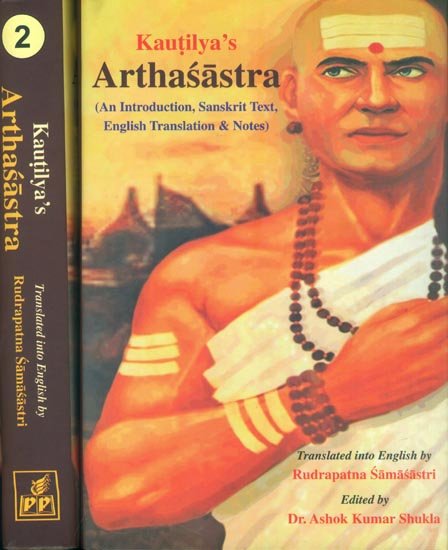Kautilya Arthashastra
by R. Shamasastry | 1956 | 174,809 words | ISBN-13: 9788171106417
The English translation of Arthashastra, which ascribes itself to the famous Brahman Kautilya (also named Vishnugupta and Chanakya) and dates from the period 321-296 B.C. The topics of the text include internal and foreign affairs, civil, military, commercial, fiscal, judicial, tables of weights, measures of length and divisions of time. Original ...
Chapter 31 - The Superintendent of Elephants
[Sanskrit text for this chapter is available]
The superintendent of elephants shall take proper steps to protect elephant forests and supervise the operations with regard to the standing or lying in stables of elephants, male, female, or young, when they are tired after training, and examine the proportional quantity of rations and grass, the extent of training given to them, their accoutrements and ornaments, as well as the work of elephant doctors, of trainers of elephants in warlike feats, and of grooms, such as drivers, binders, and others.
There shall be constructed an elephant stable twice as broad and twice as high as the length (āyāma) of an elephant, with separate apartments for female elephants, with projected entrance (sapragrīvā),[1] with posts called kumārī,[2] and with its door facing either the east or the north.
The space in front of the smooth posts (to which elephants are tied) shall form a square, one side of which is equal to the length of an elephant, and shall be paved with smooth wooden planks and provided with holes for the removal of urine and dung.
The space where an elephant lies down shall be as broad as the length of an elephant, and provided with a platform raised to half the height of an elephant for leaning on.
Elephants serviceable in war or for riding shall be kept inside the fort; and those that are still being tamed or are of bad temper shall be kept outside.
The first and the seventh of the eight divisions of the day are the two bathing times of elephants; the time subsequent to those two periods is for their food; forenoon is the time for their exercise; afternoon is the time for drink; two (out of eight) parts of the night are the time for sleep; one-third of the night is spent in taking wakeful rest.
The summer is the season to capture elephants.
That which is 20 years old shall be captured.
Young elephants (bikka),[3] infatuated elephants (mugdha),[4] elephants without tusks, diseased elephants, elephants which suckle their young ones (dhenukā), and female elephants (hastinī) shall not be captured.
(That which is) seven aratnis in height, nine aratnis in length, ten aratnis in circumference, and is (as can be inferred from such measurement) 40 years old, is the best.
That which is 30 years old is of middle class; and that which is 25 years old is of the lowest class.
The diet (for the last two classes) shall be lessened by one-quarter, according to the class.
The rations for an elephant (of seven aratnis in height) shall be one droṇa of rice, half an āḍhaka of oil, 3 prasthas of ghee, 10 palas of salt, 50 palas of flesh, one āḍhaka of broth (rasa), or twice the quantity (i.e. two āḍhakas) of curd; in order to render the dish tasteful, 10 palas of sugar (kṣāra), one āḍhaka of liquor, or twice the quantity of milk (paya); one prastha of oil for smearing over the body, one-eighth prastha (of the same) for the head and for keeping a light in the stables; two bhāras[5] of meadow grass, 2¼ bhāras of ordinary grass (śaṣpa), and 2½ bhāras of dry grass and any quantity of stalks of various pulses (kaḍaṅkara).
An elephant in rut (atyarāla) and of 8 aratnis in height shall have equal rations with that of 7 aratnis in height.
The rest of 6 or 5 aratnis in height shall be provided with rations proportional to their size.
A young elephant (bikka) captured for the mere purpose of sporting with it shall be fed with milk and meadow grass.
That which is blood-red (saṃjātalohita),[6] that which is fleshed, that which has its sides evenly grown (samaliptapakṣā), that which has its girths full or equal (samakakṣyā), that whose flesh is evenly spread, that which is of even surface on its back (samatalpatalā) and that which is of uneven surface (jātadroṇikā) are the several kinds of physical splendour of elephants.
Suitably to the seasons as well as to their physical splendour, elephants of sharp or slow sense (bhadra and mandra) as well as elephants possessed of the characteristics of other beasts shall be trained and taught suitable work.[7]
[Thus ends Chapter XXXI, “The Superintendent of Elephants,” in Book II, “The Duties of Government Superintendents” of the Arthaśāstra of Kauṭilya. End of the fifty-second chapter from the beginning.]
Footnotes and references:
[1]:
With a room at the entrance measuring nine hastas.—Com.
[2]:
A balance-like rod, mounted on the post to which an elephant is tied, is Kumārī.
[3]:
That are still sucking.—Com.
[4]:
That whose tusks are of the same length as those of a female elephant.—Com.
[6]:
When much emaciated, the body of an elephant appears blood-red. —Com.
